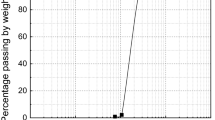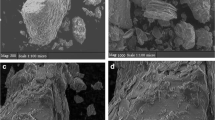Abstract
Purpose
Wettability affects water configuration and thereby transport processes and microbial activity in soil. Approaches to visualize the effect of porous media wettability on water films surrounding particles are rarely available in the literature. The aim of this study is therefore (1) to visualize the effect of wettability on area and connectivity of the water phase and (2) to develop a segmentation strategy to enable water films and bulk water to be differentiated.
Materials and methods
Wettability of silica sand was rendered by silanization using dichlorodimethylsilane. The resulting contact angle was measured using the sessile drop method. Furthermore, wettability was characterized by the water penetration time test in air-dry samples and at a volumetric water content of 8 vol.%. Sulforhodamine B was used to stain distilled water at a concentration of 40 mg/l. By means of the Wilhelmy plate method, the influence of the dye on the liquid surface tension was tested. Confocal laser scanning microscopy (CLSM) was used to visualize the area and connectivity of the fluorescent-dyed water phase and the thickness of water films in untreated and silanized samples at water contents of 8, 16, and 32 vol.%.
Results and discussion
The silanization significantly increased the contact angle of silica sand, whereas the surface tension of the dye solution did not differ significantly from that of undyed water. CLSM visualized the distribution of water, focused across the surface grain layer. Thresholding of fluorescence signal in two-dimensional intensity projections enables the discrimination between film and bulk water. It was shown that even subcritical water repellency (contact angle <90) leads to a decrease in area and connectivity of the water phase by affecting film instead of bulk water. CLSM detects decreasing effects of wettability with increasing water content, which were no longer significant at a water content of 32 vol.%. CLSM was found to be more sensitive for detecting the effects of wettability than the water drop penetration time test.
Conclusions
CLSM provides new insight into wettability-dependent water configuration. One advantage over conventional microscopy arises from the capability to visualize water focused over the pore space. Compared to other three-dimensional imaging techniques, the advantage of CLSM is its simplicity. If only the optically accessible upper layer of the porous media is of interest, sample preparation, measurements, and image analysis can easily be carried out with a cost- and time-saving setup.







Similar content being viewed by others
References
Al-Raoush RI (2009) Impact of wettability on pore-scale characteristics of residual nonaqueous phase liquids. Environ Sci Technol 43:4796–4801
Bachmann J, Horton R, Van Der Ploeg RR, Woche S (2000) Modified sessile drop method for assessing initial soil-water contact angle of sandy soil. Soil Sci Soc Am J 64:564–567
Bachmann J, Guggenberger G, Baumgartl T, Ellerbrock RH, Urbanek E, Goebel MO, Kaiser K, Horn R, Fischer WR (2008) Physical carbon-sequestration mechanisms under special consideration of soil wettability. J Plant Nutr Soil Sci 171:14–26
Box GEP, Cox DR (1964) An analysis of transformations. J Roy Stat Soc Series B Stat Methodol 26:211–252
Brismar H, Patwardhan A, Jaremko G, Nyengaard J (1996) Thickness estimation of fluorescent sections using a CSLM. J Microsc 184:106–116
Dawe R, Caruana A, Grattoni C (2011) Microscale visual study of end effects at permeability discontinuities. Transp Porous Med 86(2):601–616
Derjaguin BV, Churaev NV (1986) Flow of nonfreezing water interlayers and frost heaving. Cold Regions Sci Technol 12:57–66
Ding GC, Heuer H, Zuhlke S, Spiteller M, Pronk GJ, Heister K, Kogel-Knabner I, Smalla K (2010) Soil type-dependent responses to phenanthrene as revealed by determining the diversity and abundance of polycyclic aromatic hydrocarbon ring-hydroxylating dioxygenase genes by using a novel PCR detection system. Appl Environ Microbiol 76:4765–4771
Dwarakanath V, Jackson RE, Pope GA (2002) Influence of wettability on the recovery of NAPLs from alluvium. Environ Sci Technol 36:227–231
Ellerbrock RH, Gerke HH, Bachmann J, Goebel MO (2005) Composition of organic matter fractions for explaining wettability of three forest soils. Soil Sci Soc Am J 69:57–66
Flury M, Wai NN (2003) Dyes as tracers for vadose zone hydrology. Rev Geophys 41:21–237
Goebel MO, Bachmann J, Woche SK, Fischer WR (2005) Soil wettability, aggregate stability, and the decomposition of soil organic matter. Geoderma 128:80–93
Goebel MO, Woche SK, Bachmann J, Lamparter A, Fischer WR (2007) Significance of wettability-induced changes in microscopic water distribution for soil organic matter decomposition. Soil Sci Soc Am J 71:1593–1599
Hallett PD, Young IM (1999) Changes to water repellence of soil aggregates caused by substrate-induced microbial activity. Eur J Soil Sci 50:35–40
Herminghaus S (2005) Dynamics of wet granular matter. Adv Phys 54:221–261
Hibbs AR, MacDonald G, Garsha K (2006) Practical confocal microscopy. In: Pawley JB (ed) Handbook of biological confocal microscopy, 3rd edn. Springer, New York, pp 650–671
Iwamatsu M, Horii K (1996) Capillary condensation and adhesion of two wetter surfaces. J Colloid Interface Sci 182:400–406
Jamaloei BY, Kharrat R (2010) Analysis of microscopic displacement mechanisms of dilute surfactant flooding in oil-wet and water-wet porous media. Transp Porous Med 81:1–19
Kohout M, Grof Z, Stepanek F (2006) Pore-scale modelling and tomographic visualisation of drying in granular media. J Colloid Interface Sci 299:342–351
Letey J (1969) Measurement of contact angle, water drop penetration time, and critical surface tension. In: DeBano LF, Letey J (ed), Proc Symp Water-repellent Soils Univ Calif, Riverside
Li Y, Dick WA, Tuovinen OH (2004) Fluorescence microscopy for visualization of soil microorganisms—a review. Biol Fertil Soils 39:301–311
Meinhart CD, Wereley ST, Santiago JG (1999) PIV measurements of a microchannel flow. Exp Fluids 27:414–419
Morrow NR (1976) Capillary-pressure correlations for uniformly wetted porous-media. J Can Pet Tech 15:49–69
Or D, Smets BF, Wraith JM, Dechesne A, Friedman SP (2007) Physical constraints affecting bacterial habitats and activity in unsaturated porous media—a review. Adv Water Resour 30:1505–1527
Pawley JB (2006) Fundamental limits in confocal microscopy. In: Pawley JB (ed) Handbook of biological confocal microscopy, 3rd edn. Springer, New York, pp 20–42
Pidwirny M (2006) Infiltration and soil water storage. Fundamentals of physical geography, 2nd edn. http://www.physicalgeography.net/fundamentals/8l.html. Accessed 18 Nov 2010
Regalado C, Ritter A (2009) A soil water repellency empirical model. Vadose Zone J 8:136–141
Shahidzadeh-Bonn N, Tournie A, Bichon S, Vie P, Rodts S, Faure P, Bertrand F, Azouni A (2004) Effect of wetting on the dynamics of drainage in porous media. Transp Porous Med 56:209–224
Shahidzadeh-Bonn N, Azouni A, Coussot P (2007) Effect of wetting properties on the kinetics of drying of porous media. J Phys Condens Matter. doi:10.1088/0953-8984/19/11/112101
Shirtcliffe NJ, McHale G, Newton MI, Pyatt FB, Doerr SH (2006) Critical conditions for the wetting of soils. Appl Phys Lett. doi:10.1063/1.2339072
Siebold A, Walliser A, Nardin M, Oppliger M, Schultz J (1997) Capillary rise for thermodynamic characterization of solid particle surface. J Colloid Interface Sci 186:60–70
Stelzer EHK (2006) The intermediate optical system of laser-scanning confocal microscopes. In: Pawley JB (ed) Handbook of biological confocal microscopy, 3rd edn. Springer, New York, pp 207–220
Wallis MG, Scotter DR, Horne DJ (1991) An evaluation of the intrinsic sorptivity water repellency index on a range of New Zealand soils. Aust J Soil Res 29:353–362
Werth CJ, Zhang CY, Brusseau ML, Oostrom M, Baumann T (2010) A review of non-invasive imaging methods and applications in contaminant hydrogeology research. J Contam Hydrol 113:1–24
White NS (2006) Visualization systems for multi-dimensional microscopy images. In: Pawley JB (ed) Handbook of biological confocal microscopy, 3rd edn. Springer, New York, pp 280–315
Wilhelm S, Gröbler B, Gluch M, Heinz H (2003) Confocal laser scanning microscopy. Principles Carl Zeiss. http://www.agriculture.purdue.edu/clsm/img/CLSM%20Principles.pdf. Accessed 24 Feb 2011
Yang XF, Xi T (1995) Critical wetting angle for spontaneous liquid infiltration into orderly packed fibres or spheres. J Mater Sci 30:5099–5102
Zevi Y, Dathe A, McCarthy JF, Richards BK, Steenhuis TS (2005) Distribution of colloid particles onto interfaces in partially saturated sand. Environ Sci Technol 39:7055–7064
Acknowledgments
We received most valuable technical assistance from Dr. Susanne K. Woche and Martin Volkmann from the Institute of Soil Science at the Leibniz University of Hannover. This project was financed by the German Research Foundation in priority program 1315 Biogeochemical Interfaces in Soil.
Author information
Authors and Affiliations
Corresponding author
Additional information
An erratum to this article can be found at http://dx.doi.org/10.1007/s11368-011-0422-8
Rights and permissions
About this article
Cite this article
Müehl, G.J.H., Rüehlmann, J., Goebel, MO. et al. Application of confocal laser scanning microscopy (CLSM) to visualize the effect of porous media wettability on unsaturated pore water configuration. J Soils Sediments 12, 75–85 (2012). https://doi.org/10.1007/s11368-011-0395-7
Received:
Accepted:
Published:
Issue Date:
DOI: https://doi.org/10.1007/s11368-011-0395-7




